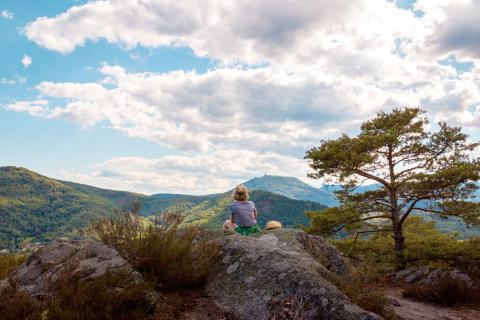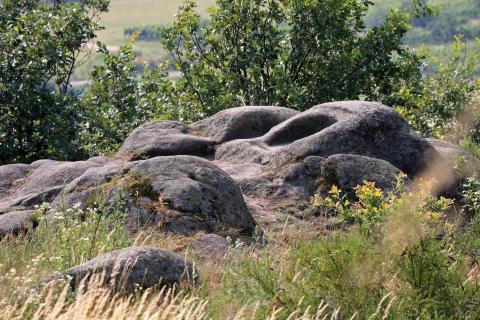5 unique places to discover
With mysteries, legends and monumental artwork, the region of Sélestat and Haut-Koenigsbourg will amaze and surprise you.
Get off the beaten path! Explore a few places that are as fascinating as they are unusual. Absolute must-sees!
The Celtic Rock in Dieffenthal
Come see this strange, hollowed-out rock, steeped in history and Celtic legends. On the Alsace Wine Route, not far from the charming little church of the village of Dieffenthal, the Celtic Rock sits high above the vineyards, where you can enjoy a breathtaking view of the Alsatian Plain. And on clear days, you can even see the Black Forest in the distance. It has been said that this rock, in the form of a basin (cup marks), was used in Celtic times as a birthing chair. It is at this iconic site that, in wintertime (in February), “Schieweschlawe” is usually held. This ceremony, in which glowing disks are flung, is a Celtic tradition that chases winter away and celebrates the coming of spring. If you’d like to continue your exploration, you could hike on the Trail of Rocks (for the short 45-minute hike, follow the blue rings. For the longer hike lasting about 2 hours, follow the yellow rings). For a fun family activity, solve the riddles of a treasure hunt, called “The Mysteries of Dieffenthal”.
Destination Scherwiller, the village with 100 lavoirs
Located on the Alsace Wine Route, about 6 kilometres from Sélestat, this village, the capital of Riesling wine, has a unique feature to discover.
Originally, the name “Scherwiller” referred to the hamlet on the banks of the Scheer River. This was the old name of the river that runs through the village. The river is now known as the Aubach and it also runs through Ebersheim. A listed site, Aubach River features nearly a hundred lavoirs, or public wash basins for laundry, made of pink sandstone from the Vosges Mountains, along a 1.5-kilometre stretch of its banks. Many of the lavoirs had space for two, providing friendly face-to-face opportunities where people could catch up on the latest village gossip. Stroll along the Aubach, stopping to admire the winemakers’ homes and farmhouses on its banks, dating from the 16th to the 19th centuries, several of which have been restored and repainted. The cellars and ground floors of these pretty houses are made of rubble stone, while the upper stories have timber-frame structures. A mix of tradition and modernity that will amaze you.
As the seasons change, the river changes, too, offering different scenes to admire: at various times of the year, it may be frozen, dry or surrounded by a multitude of geraniums. But it’s in summertime that the lavoirs come back to life, thanks to the Lavandières street theatre, where scenes of rural life in the village are played out, in French and Alsatian. You’ll travel back in time! Take a break in the communal Medieval Garden, where you’ll be immersed in tales and poems about courtly love. Feel like exploring some more? We recommend The Mysteries of the Vineyard: Scherwiller. During this fun walk, you’ll get a chance to admire the old wooden screw press. Don’t forget to lift your eyes to admire the rooftops of certain houses! See you soon, in Scherwiller!
Contemporary artwork: “Meeting Point: The Dream of Sarkis”
Go to Quai de l’Ill in Sélestat, on the banks of the river, to indulge in a little daydreaming.
This place is both quirky and amazing. Although you can see the old Vauban fortifications of this City of Art and History in the distance, it’s quite surprising to see these strange rows of 310 street signs mounted on the bastion of the ramparts. The enamel signs display words, phrases or poems that fire the imagination and celebrate creativity. Why are there 310 signs? Because that’s how many streets there were in Sélestat in 1993, when this artwork was created by the artist, Sarkis. A few of the signs were left blank, to symbolise the future expansion of the city. The artist chose this location because he found it conducive to encounters and conversations. It’s also a stop on the city walking tour “In the Footsteps of the Lion and the Giant Sletto”. Time to daydream...
Chalmont Rock in La Vancelle
This rocky outcrop is a place of legends. At an altitude of 704 metres, it’s a 45-minute walk from the small town of La Vancelle (car park at the church).
At the summit, you’ll find huge blocks of Vosges sandstone that have been shaped by time. Catch your breath at the viewpoint and enjoy a stunning view of the valleys of Liepvrette and Sainte-Marie-aux-Mines, facing the Taennchel and Haut-Koenigsbourg Mountain, at the top of which sits the famous Haut-Koenigsbourg Castle. According to legend, it is called Charlemagne Rock because he had a fortified castle on the ridge of Chalmont, and he sat on the rock. Close to the scenic viewpoint, set in stone forever, you can see the print of a horseshoe, believed to be from Charlemagne’s horse. According to another legend, one of his daughters is buried at the base of the rock. Finally, it is also said that fairies wanted to build a bridge over the valley between Chalmont and the Taennchel. Set off to explore this mountain and learn more about these fascinating legends. For the most athletic visitors, a loop hiking trail will take you from La Vancelle, through Frankenbourg Pass, past the Castle of Frankenbourg, the Rocher du Coucou, Chalmont and back to La Vancelle (4-hour hike).
The protective niches of Ebersheim
Ebersheim is located at the heart of the region, in the Ried. As you explore this village on foot or on a bike, year-round, you’ll see remarkable examples of niches containing statues on the gables or facades of houses, and even on the siding of barns and tobacco drying sheds. There are more than thirty of these niches in the village. Quite amazing for this little village, close to Sélestat, the birthplace of Rhenish humanism.
Also called niches of protection, niches of devotion or pious niches, they consist either of a decorated glass-covered nook or a box mounted on the wall, containing statuettes of the Holy Family, saints and sometimes icons. Many of them are statuettes of the Virgin Mary, while others depict Jesus, Saint Odile or Saint Anthony of Padua. Statuettes of a Black Virgin holding a child are similar to the Black Madonnas of Rocamadour and Saintes-Maries-de-la Mer, in France, and of Montserrat, in Spain. It is said that many of the niches were built at the behest of the Church and the village priest.
Originally, these holy niches were believed to protect against fire, which makes sense in a village with so many barns and, importantly, tobacco drying sheds. Although the oldest niches date back to around 1750, most of them were made in the post-war period, and some were built in memory of a happy or sad event related to the war. So stop, and look up! Tour map
Other curiosity in the village: The Water Drop Trail







 Getting here
Getting here Wondering
Wondering Escapade
Escapade Plan your trip
Plan your trip Discover
Discover Agenda
Agenda Infos pratiques
Infos pratiques